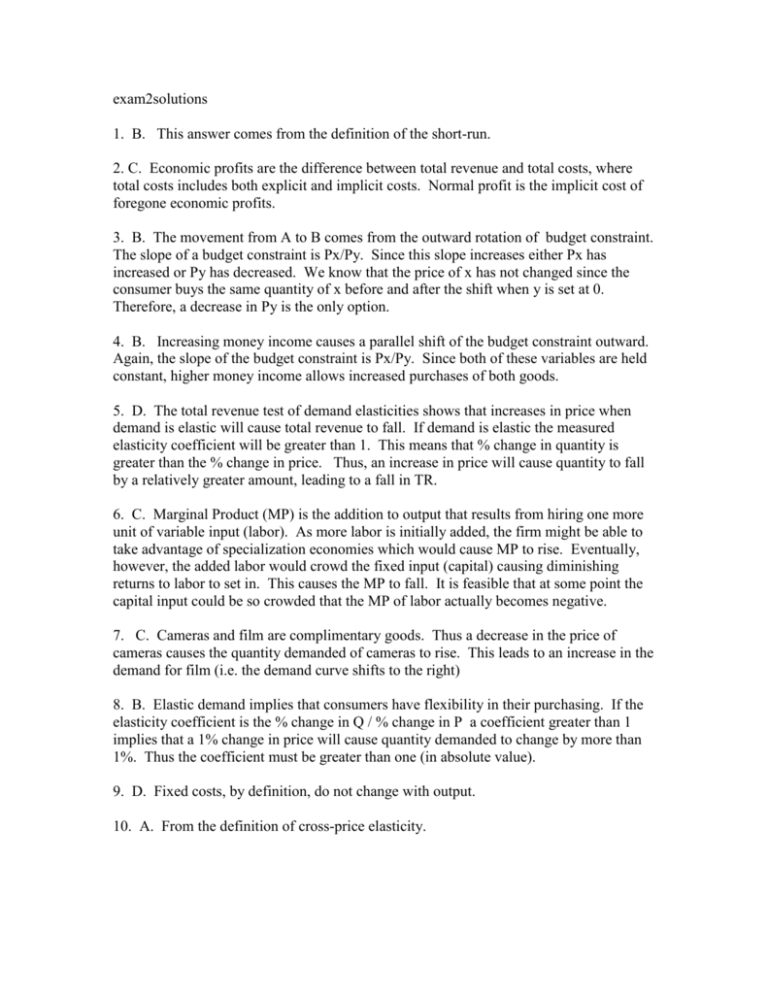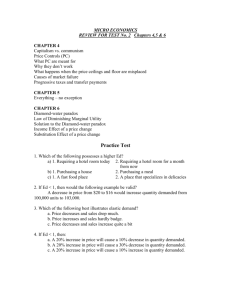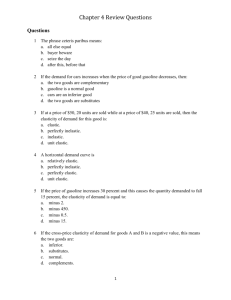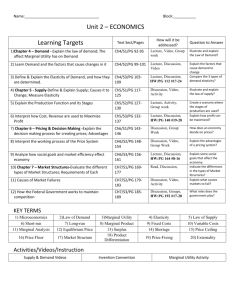exam2solutions
advertisement

exam2solutions 1. B. This answer comes from the definition of the short-run. 2. C. Economic profits are the difference between total revenue and total costs, where total costs includes both explicit and implicit costs. Normal profit is the implicit cost of foregone economic profits. 3. B. The movement from A to B comes from the outward rotation of budget constraint. The slope of a budget constraint is Px/Py. Since this slope increases either Px has increased or Py has decreased. We know that the price of x has not changed since the consumer buys the same quantity of x before and after the shift when y is set at 0. Therefore, a decrease in Py is the only option. 4. B. Increasing money income causes a parallel shift of the budget constraint outward. Again, the slope of the budget constraint is Px/Py. Since both of these variables are held constant, higher money income allows increased purchases of both goods. 5. D. The total revenue test of demand elasticities shows that increases in price when demand is elastic will cause total revenue to fall. If demand is elastic the measured elasticity coefficient will be greater than 1. This means that % change in quantity is greater than the % change in price. Thus, an increase in price will cause quantity to fall by a relatively greater amount, leading to a fall in TR. 6. C. Marginal Product (MP) is the addition to output that results from hiring one more unit of variable input (labor). As more labor is initially added, the firm might be able to take advantage of specialization economies which would cause MP to rise. Eventually, however, the added labor would crowd the fixed input (capital) causing diminishing returns to labor to set in. This causes the MP to fall. It is feasible that at some point the capital input could be so crowded that the MP of labor actually becomes negative. 7. C. Cameras and film are complimentary goods. Thus a decrease in the price of cameras causes the quantity demanded of cameras to rise. This leads to an increase in the demand for film (i.e. the demand curve shifts to the right) 8. B. Elastic demand implies that consumers have flexibility in their purchasing. If the elasticity coefficient is the % change in Q / % change in P a coefficient greater than 1 implies that a 1% change in price will cause quantity demanded to change by more than 1%. Thus the coefficient must be greater than one (in absolute value). 9. D. Fixed costs, by definition, do not change with output. 10. A. From the definition of cross-price elasticity. 11. A. If the demand for labor is inelastic an increase in the price of labor (the wage rate) will lead to an increase in overall wages paid. The increase is wages is relatively larger than the decrease in quantity demanded of labor. 12. B. If the MU per last dollar spent on one good (good A) is greater than the MU per last dollar spent on a second good (good B), the consumer can increase overall satisfaction by shifting fixed money income away from B allowing her to buy more A. Assuming diminishing marginal utility, this will cause the MU of A to fall and the MU of B to rise. Eventually an utility maximizing bundle is achieve where the MU per last dollar spent on both goods is equalized. 13. A. If the firm increases output, it will have to use its plant more intensely. This will increase the amount of energy that it consumes. Thus, energy costs vary with output. 14. A. From the definition of the income effect. 15. B. The main determinant of demand elasticities is the number of available substitutes. Since all soft drinks are substitutes for Coke, the demand for Coke must be more elastic than the demand for soft drinks. 16. D. Points on the PPC show combinations of 2 goods that can be produced when all resources are fully and efficiently employed. Therefore increasing the production of one good (consumer goods) necessitates shifting resources away from producing the 2nd good. 17. C. Greater utility is represented on higher indifference curves. Because point 3 is on a higher indifference curve than either points 1 or 5, the consumer receives more utility from this bundle. 18. C. Marginal product is the addition to total output that comes from hiring the last worker. If marginal product is 0 the firm has squeezed all of the output that it can from its workers. MP is at its maximum at the point where diminishing returns to labor set in. Moving beyond this point means that each additional worker will add less to output than the previous worker, but still might add a positive amount. 19. B. If prices rise, the consumer can afford fewer goods given the same money income. This suggests that the consumer’s budget constraint shifts inwards, or to the left. 20. A. See explanation of the total revenue test in #5. 21. B. As the time horizon increases farmers (the suppliers of pork) have the ability to shift more resources to pork production in response to price changes in the market. Thus short-run supply is more inelastic than long-run supply. 22. B. Utility is maximized when the MU per last dollar spent on one good is equal to the MU per last dollar spent on all other goods. If the last unit of A gives 12 utils of utility and the last unit of B gives 8 utils of utility, then the respective prices of A and B must be $6 and $4. 23. A. Total costs includes both explicit costs (or those costs that there is a monetary outlay for), and implicit costs (the opportunity costs of using a resource for producing the good). The normal profit is the opportunity costs of foregone profits, or the profits that could have been earned in the next best business opportunity. Because a firm gives up these profits they are included in implicit costs. 24. C. The price elasticity of demand is the % change in q / % change in P. An elasticity coefficient of .2 means that a 10% increase in price causes a 2% decrease in quantity demanded. 25. C. See explanation in #18. 26. D. If demand is elastic then consumers are relatively insensitive to price changes. A shift in the supply curve will therefore cause a relatively large change in quantity demanded, but a small change in price with elastic demand. 27. A or D. The marginal product is the addition to total output that results from hiring the last worker. The second worker adds 18 units and the third worker adds 9 units to the firm’s output. 28. C. If the initial price is above the equilibrium price, firms will decrease price to reduce unnecessary inventory costs. The lower price causes a movement down along the both the demand and supply curves, so quantity demanded rises and quantity supplied falls. 29. C. Only an increase in demand will raise both the quantity and price (tuition). The choices in option C are all determinants of demand. 30. D. The PPC is defined assuming full employment and productive efficiency. If an economy fails to achieve either the combination of goods and services that it produces will be inside the PPC. 31. A. From the definition of inelastic. 32. D. If an indifference curve is closer to the origin the consumption of both goods will be lower. This implies a lower level of utility. 33. C. MU is the change in total utility that results from consuming the last unit. After two units Craig has 30 units of total utility. Therefore the marginal utility of the 3rd unit is 8.










